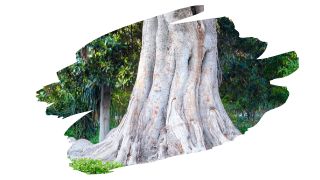There’s a world of options on offer when it comes to choosing outdoor lumber. For example tropical hardwoods in particular, such as Rosewood and Teak, are incredibly rot-resistant.
And while some types of lumber require a sealant, those two hardwoods rarely need any. This makes them ideal for anyone looking to build an outdoor space that looks great without any extra effort.
Still, Elm wood is yet another hardwood with somewhat of a reputation for being resistant to decay. So, why doesn’t Elm wood come up more often as a choice for outdoor furniture?
Well, in this post, you will discover what the best wood is for outdoor furniture. You’ll also learn why Elm woods water-submerging resistance to decay, doesn’t count for much on dry ground.

This post may contain affiliate links to products that we receive a commission for (at no additional cost to you). Learn more here.
What’s The Best Type Of Timber For Outdoor Furniture?
Teak wood is quite possibly one of the best options for any garden furniture set. It doesn’t matter if you live in a hot or humid climate, this durable water-resistant lumber can handle the great outdoors.
That is because this tropical hardwood has a lot of natural tree oil saturating its grain. And this oil coats the fibers of Teak, preventing water from being readily absorbed by this timber. And that oil is thick enough that even termites struggle to bore their way down into Teak wood.
This natural water-resistance means that Teak wood doesn’t warp and shift around much either. So that’s why this wood is not only popularly use for outdoor furniture, but also for boat decking.
Related Post: Can You Apply Lemon Oil On A Teak Wood Surface?
But, Teak wood is a pretty pricey lumber, which is why White Oak is a more wallet-friendly alternative.
Although not as resilient as Teak wood, White Oak won’t decay quickly. In fact, White Oak has some rather special traits that make it better at handling the great outdoors.
If you’re curious about using white oak for a garden set or outdoor decking, then check out our article here: Is White Oak Good For Making Durable Outdoor Furniture?
What About Elm Wood? What Is Elm Wood Good For?
Well, Elm wood heartwood is a surprisingly shock-absorbent lumber. Thanks to its spiraling interlocking grain, this wood may be fairly soft for a hardwood, but that doesn’t mean it can be split easily.
Now, that interlocking grain is the key to elm woods toughness. Yet, at the same time, it also makes this wood difficult to machine and work with.
So, in theory, this durability should make Elm wood good for outdoor furniture, right? Not exactly…
Elm Wood Can Warp A Lot As It Seasons
You see, beyond its twisting tree stem, its really difficult to season Elm wood without it warping.
When we season trees, we’re trying to reduce their natural moisture content. This typically involves allowing freshly logged wood to dry out slowly over a matter of months.
Related Post: How To Season Wood (7 Tips)
However, Elm wood is notorious for warping and twisting as you season it. Still, if you can keep it flat as it seasons, this wood can be used for interior furniture pieces.
Elm Wood Is Not Rot-Resistant
Unlike Teak wood, Elm wood is vulnerable to wood rot, decay and bugs.
It doesn’t matter if its Red Elm or English Elm. This tree species simply does not have a natural defense from the effects of repeated water absorption.
But I Read That Elm Wood Was Resistant To Decay?
Elm woods reputation for being water-resistant comes from the fact that if it’s permanently submerged in water, it doesn’t decay. Which is why Elm wood has been used to make the bottoms of marine vessels.
But, if Elm wood gets put through regular wet/dry cycles, then this wood can succumb to rot. So, regular rain showers followed by the drying out effects of sunshine afterward, will quickly weather Elm wood furniture.
Nevertheless, Can You Use Elm Wood For Outdoor Furniture Anyway?
There is a lot of rain and humidity outside. Not even a quality exterior sealer can prevent humid moisture from worming its way into the wood underneath.
Which is why exterior timber needs to hold its own against rot and moisture — even without a weatherproofing finish or sealant to protect it.
Take exterior wood stains, for example. These finishes often have additives for waterproofing, mildew resistance and even UV protection. In fact, you can learn more about the protective capabilities of exterior wood stains here: Can You Really Use Decking Stain On Garden Furniture?
Having said that, Elm wood isn’t capable of lasting, no matter the weather-resistant exterior stain or sealant. Especially if Elm wood furniture has direct ground contact (i.e. you leave the furniture sitting atop grass).
Related Post: Is Hickory Wood A Good Choice For Outdoor Furniture?
So What Does This Mean For My Dreams Of An Elm Wood Garden Set?
You should shelve those dreams for now. And, for the sake of your time and money, opt for a more suitable outdoor wood choice for your backyard.
To Wrap Up, Here Are The 3 Key Takeaways From This Post…
- 1). Elm wood can resist decay if it is left permanently submerged in water.
- 2). However, Elm wood will succumb to rot when exposed to a constant wet/dry weather cycle.
- 3). Elm woods vulnerability to rot and bug attacks makes it a poor choice for outdoor furniture.
References:
Kazemi, Seyed Mahmoud, and Mehran Jalilvand. “Investigation on wood plastic composite resistance against water, fire and fungal attack compared to untreated maple and elm.” (2008): 81-98.
Elm | Wikipedia.org



